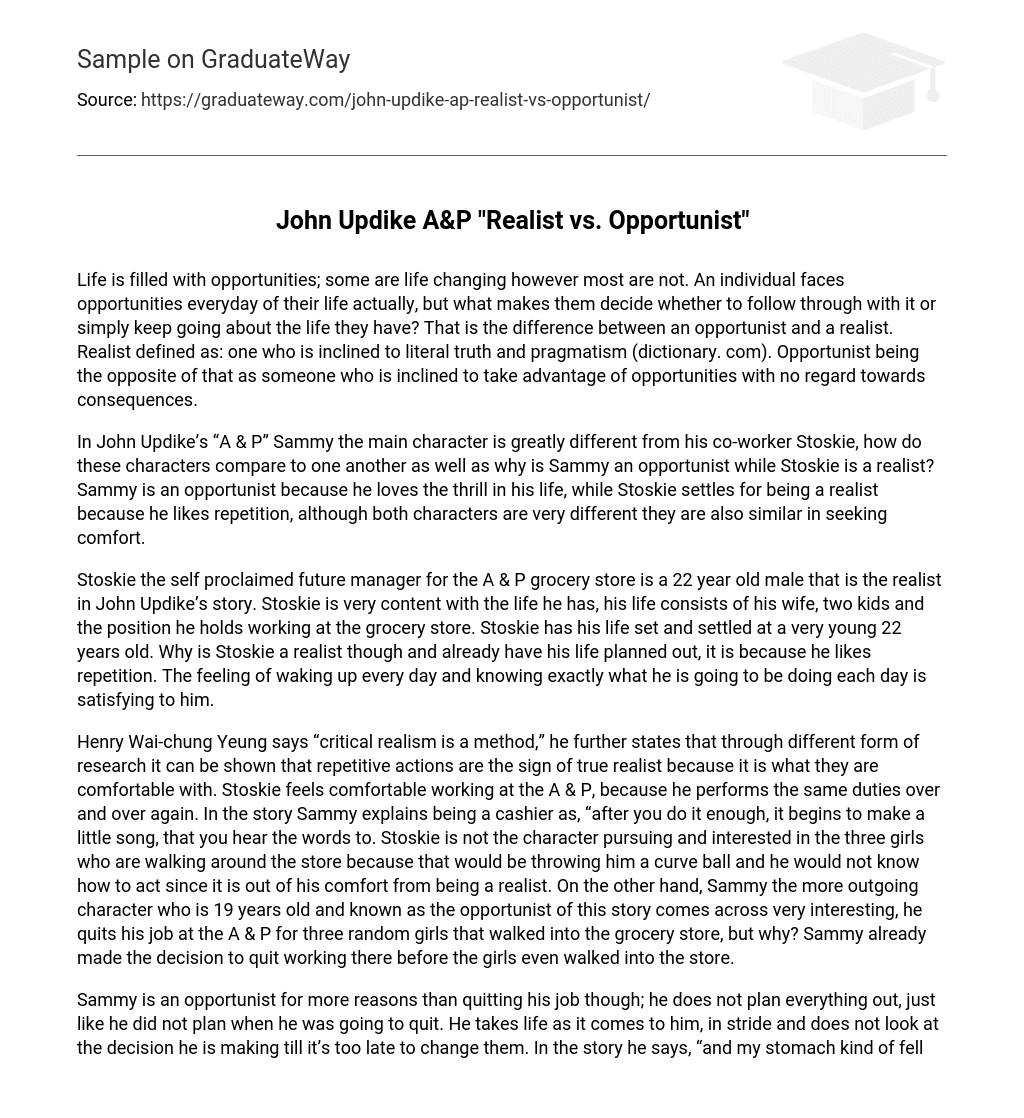Life presents countless opportunities, some of which have the power to completely transform our lives. However, the majority of opportunities we encounter are not as impactful. On a daily basis, individuals face a multitude of opportunities, prompting them to choose between pursuing them or maintaining their current lifestyle. This decision ultimately differentiates opportunists from realists. A realist, defined by dictionary.com, is someone who tends to prioritize factual truth and practicality. Conversely, an opportunist is someone who seizes opportunities without considering the potential consequences.
The main characters in John Updike’s “A & P,” Sammy and Stoskie, differ greatly in their personalities. While Sammy is an opportunist who craves excitement in his life, Stoskie is a realist who finds comfort in routine. Despite their differences, both characters share a desire for comfort.
Stoskie, the self-proclaimed future manager for the A & P grocery store, is a 22-year-old male who embodies realism in John Updike’s story. Content with his current life situation, Stoskie cherishes his wife, two kids, and position at the grocery store. At such a young age, Stoskie has already established and settled into his life. The reason behind Stoskie’s realism and future plans lies in his appreciation for repetition. The satisfaction he derives from waking up every day and knowing exactly what his day will consist of resonates deeply with him.
Henry Wai-chung Yeung argues that critical realism is a method and asserts that repetitive actions indicate true realists, as they are comfortable with routine. Stoskie, who works at the A & P, finds comfort in performing the same tasks repeatedly. In the story, Sammy, a cashier, describes how the job becomes familiar and even has a rhythm. Stoskie, being a realist, is not interested in the three girls wandering around the store as it would disrupt his comfort zone. Conversely, Sammy, a more outgoing character and opportunist at 19 years old, is intrigued by the girls and quits his job at the A & P for them. Interestingly, Sammy had already made the decision to leave before the girls even entered the store.
Sammy is an opportunist not only because he quit his job without planning it, but also because he approaches life without thinking about the consequences. In the story, he realizes the difficulties he will face in the future and describes himself as a true opportunist. According to the dictionary’s definition, an opportunist is someone who takes advantage of any opportunity without considering principles or consequences. Lawrence Jay Dessner also characterizes Sammy’s action as a lack of concern for the consequences of quitting his job abruptly. Despite being handed an opportunity, Sammy’s disregard for consequences results in negative outcomes, such as losing his source of income and causing distress to his parents who are friends with the store manager. Updike’s “A & P” highlights the contrast between an opportunist and a realist.
Sammy and Stoskie are two contrasting characters. Sammy, an outgoing opportunist, constantly experiences adventure and excitement in his life, which keeps him on his toes. On the other hand, Stoskie is the complete opposite, being settled and non-eccentric, much like a realist due to his old age. In one particular instance in the story, an old lady and teenage girls approach the registers simultaneously. The elderly woman symbolizes being settled and non-eccentric, similar to Stoskie. In contrast, the half-naked and barefoot teenage girls symbolize opportunism like Sammy, as their outgoing lives are filled with adventure and excitement.
The elderly woman opts for Stoskie’s register while the teenage girls opt for Sammy’s register. Throughout the story, Sammy is constantly alert and engaged because that’s what he enjoys. He could have been more like Stoskie, but his natural inclination is to seek excitement and seize opportunities. While the girls were exploring the grocery store aisles, Sammy was patiently anticipating something to occur. He wasn’t sure what it would be, but he sensed it was imminent.
According to Dessner (par 3), instead of focusing on his job duties, the worker, known as Sammy, indulges in ogling and idolizing the most attractive and self-assured of three girls passing by his work station. Despite being a realist, Stoskie briefly diverts his attention from his responsibilities to observe the girls. However, he refrains from pursuing any further interest in them as his main focus remains on fulfilling his role as a cashier.
Although Stoskie and Sammy have contrasting personalities, they share a common desire for comfort. This similarity makes them either an opportunist or a realist. Sammy finds contentment in his current life, even if others may view the excitement he gets from living on the edge as unsettling. However, Stoskie values comfort and finds solace in knowing what each day holds, avoiding risky situations. In my opinion, comfort is a universal pursuit as it alleviates worries and concerns.
The difference between the life of an opportunist and a realist is profound. Stoskie, being a realist, is content and at ease with his repetitive existence, accepting his life as it is. On the other hand, Sammy, a youthful 19-year-old, embodies the opportunistic mindset, constantly seeking new experiences without considering the consequences until it is too late. These two characters lead contrasting lives, each finding comfort in their own unique approaches. John Updike’s “A & P” can be considered a classic due to the significant contribution of these underlying character traits to the narrative.





